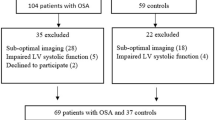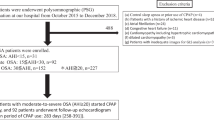Abstract
Purpose
This study aims to assess changes in cardiac imageology of patients with mild obstructive sleep apnea (OSA) without cardiovascular disease.
Methods
All enrolled participants underwent polysomnography (PSG). Some participants underwent transthoracic echocardiography, speckle tracking echocardiography, and cardiac-enhanced magnetic resonance imaging (MRI) if they were willing. They were divided into three groups according to PSG results: non-OSA, mild OSA, and moderate-to-severe OSA. Imageology parameters were compared, and the relationship between OSA severity and imageology indices was analyzed by correlation analysis and multiple linear regression.
Results
Of the 352 enrolled participants, 274 participants with OSA had an apnea–hypopnea index (AHI) of ≥ 5 (86 mild OSA and 188 moderate-to-severe OSA cases), and 78 participants with non-OSA had an AHI of < 5. Transthoracic echocardiography showed that E/A and E’/A’ values were lower in the mild OSA group than in the non-OSA group (1.12 ± 0.37 vs 1.27 ± 0.45 and 0.83 ± 0.33 vs 0.99 ± 0.42, respectively, p < 0.05). The aorta and ascending aorta widths were smaller in the mild OSA group than in the moderate-and-severe OSA groups (27.36 ± 2.87 mm vs 28.87 ± 2.95 mm and 30.27 ± 3.79 mm vs 31.63 ± 3.74 mm, respectively, p < 0.05). A regression analysis showed that cardiac function changes in patients with OSA may be related to age, obesity, and OSA severity.
Conclusion
Patients with mild OSA without cardiovascular disease displayed changes in cardiac structure and function on transthoracic echocardiography.

Similar content being viewed by others
Data availability
The detailed participant data are available from the corresponding author upon reasonable request.
References
Benjafield AV, Ayas NT, Eastwood PR et al (2019) Estimation of the global prevalence and burden of obstructive sleep apnoea: a literature-based analysis. Lancet Respir Med 7:687–698. https://doi.org/10.1016/S2213-2600(19)30198-5
Yaggi H, Concato J, Kernan W, Lichtman J, Brass L, Mohsenin V (2005) Obstructive sleep apnea as a risk factor for stroke and death. N Engl J Med 353:2034–2041. https://doi.org/10.1056/NEJMoa043104
Young T, Finn L, Peppard PE et al (2008) Sleep disordered breathing and mortality: eighteen-year follow-up of the Wisconsin sleep cohort. Sleep 31:1071–1078. https://doi.org/10.5665/sleep/31.8.1071
Marin JM, Carrizo SJ, Vicente E, Agusti AGN (2005) Long-term cardiovascular outcomes in men with obstructive sleep apnoea-hypopnoea with or without treatment with continuous positive airway pressure: an observational study. Lancet 365:1046–1053. https://doi.org/10.1016/S0140-6736(05)71141-7
Chetan IM, Domokos Gergely B, Albu A, Tomoaia R, Todea DA (2020) Understanding the role of echocardiography in patients with obstructive sleep apnea and right ventricular subclinical myocardial dysfunction - comparison with other conditions affecting RV deformation. Med Ultrason https://doi.org/10.11152/mu-2727
Altekin RE, Yanikoglu A, Baktir AO et al (2012) Assessment of subclinical left ventricular dysfunction in obstructive sleep apnea patients with speckle tracking echocardiography. Int J Cardiovasc Imaging 28:1917–1930. https://doi.org/10.1007/s10554-012-0026-4
Haruki N, Takeuchi M, Kanazawa Y et al (2010) Continuous positive airway pressure ameliorates sleep-induced subclinical left ventricular systolic dysfunction: demonstration by two-dimensional speckle-tracking echocardiography. Eur J Echocardiogr 11:352–358. https://doi.org/10.1093/ejechocard/jep215
Buonauro A, Galderisi M, Santoro C et al (2017) Obstructive sleep apnoea and right ventricular function: a combined assessment by speckle tracking and three-dimensional echocardiography. Int J Cardiol 243:544–549. https://doi.org/10.1016/j.ijcard.2017.05.002
Lei W, Zhibin W, Wugang W, Junfang L, Yong L (2015) Speckle tracking imaging in assessing left ventricular function of obstructive sleep apnea. Chin J Med Imaging 12:913–916
White SK, Sado DM, Fontana M et al (2013) T1 mapping for myocardial extracellular volume measurement by CMR: bolus only versus primed infusion technique. JACC Cardiovasc Imaging 6:955–962. https://doi.org/10.1016/j.jcmg.2013.01.011
Won S, Davies-Venn C, Liu S, Bluemke DA (2013) Noninvasive imaging of myocardial extracellular matrix for assessment of fibrosis. Curr Opin Cardiol 28:282–289. https://doi.org/10.1097/HCO.0b013e32835f5a2b
Miller CA, Naish JH, Bishop P et al (2013) Comprehensive validation of cardiovascular magnetic resonance techniques for the assessment of myocardial extracellular volume. Circ Cardiovasc Imaging 6:373–683. https://doi.org/10.1161/CIRCIMAGING.112.000192
Hayashi T, Yamashita C, Matsumoto C et al (2008) Role of gp91phox-containing NADPH oxidase in left ventricular remodeling induced by intermittent hypoxic stress. Am J Physiol Heart Circ Physiol 294:H2197–H2203. https://doi.org/10.1152/ajpheart.91496.2007
Chen L, Zhang J, Gan TX et al (2008) Left ventricular dysfunction and associated cellular injury in rats exposed to chronic intermittent hypoxia. J Appl Physiol 104:218–223. https://doi.org/10.1152/japplphysiol.00301.2007
Peppard PE, Young T, Palta M, Skatrud J (2000) Prospective study of the association between sleep-disordered breathing and hypertension. N Engl J Med 342:1378–1384. https://doi.org/10.1056/nejm200005113421901
Shahar E, Whitney CW, Redline S et al (2001) Sleep-disordered breathing and cardiovascular disease: cross-sectional results of the Sleep Heart Health Study. Am J Respir Crit Care Med 163:19–25. https://doi.org/10.1164/ajrccm.163.1.2001008
Jaimchariyatam N, Rodriguez CL, Budur K (2010) Does CPAP treatment in mild obstructive sleep apnea affect blood pressure? Sleep Med 11:837–842. https://doi.org/10.1016/j.sleep.2010.05.005
Vgontzas AN, Li Y, He F, et al (2019) Mild-to-moderate sleep apnea is associated with incident hypertension: age effect. Sleep 42:zsy265. doi:https://doi.org/10.1093/sleep/zsy265
Bouloukaki I, Grote L, McNicholas WT et al (2020) Mild obstructive sleep apnea increases hypertension risk, challenging traditional severity classification. J Clin Sleep Med 16:889–898. https://doi.org/10.5664/jcsm.8354
Drager LF, Bortolotto LA, Lorenzi MC et al (2005) Early signs of atherosclerosis in obstructive sleep apnea. Am J Respir Crit Care Med 172:613–618. https://doi.org/10.1164/rccm.200503-340OC
Kapur VK, Auckley DH, Chowdhuri S et al (2017) Clinical practice guideline for diagnostic testing for adult obstructive sleep apnea: an American Academy of Sleep Medicine clinical practice guideline. J Clin Sleep Med 13:479–504. https://doi.org/10.5664/jcsm.6506
Lombardi C, Pengo MF, Parati G (2018) Systemic hypertension in obstructive sleep apnea. J Thorac Dis 10:S4231–S4243. https://doi.org/10.21037/jtd.2018.12.57
Frangopoulos F, Nicolaou I, Zannetos S, Economou NT, Adamide T, Trakada G (2020) Association between respiratory sleep indices and cardiovascular disease in sleep apnea-a community-based study in Cyprus. J Clin Med 9:2475. https://doi.org/10.3390/jcm9082475
Mandal S, Kent BD (2018) Obstructive sleep apnoea and coronary artery disease. J Thorac Dis 10:S4212–S4220. https://doi.org/10.21037/jtd.2018.12.75
Cadby G, McArdle N, Briffa T et al (2015) Severity of OSA is an independent predictor of incident atrial fibrillation hospitalization in a large sleep-clinic cohort. Chest 148:945–952. https://doi.org/10.1378/chest.15-0229
Peker Y, Thunström E, Glantz H, Eulenburg C (2020) Effect of obstructive sleep apnea and CPAP treatment on cardiovascular outcomes in acute coronary syndrome in the RICCADSA Trial. J Clin Med 9:4051. https://doi.org/10.3390/jcm9124051
Baguet JP, Nadra M, Barone-Rochette G, Ormezzano O, Pierre H, Pépin JL (2009) Early cardiovascular abnormalities in newly diagnosed obstructive sleep apnea. Vasc Health Risk Manag 5:1063–1073. https://doi.org/10.2147/vhrm.s8300
Raut S, Gupta G, Narang R et al (2021) The impact of obstructive sleep apnoea severity on cardiac structure and injury. Sleep Med 77:58–65. https://doi.org/10.1016/j.sleep.2020.10.024
Kwon Y, Logan J, Redline S et al (2019) Obstructive sleep apnea and structural/functional properties of the thoracic ascending aorta: the Multi-Ethnic Study of Atherosclerosis (MESA). Cardiology 142:180–188. https://doi.org/10.1159/000499500
Kiely JL, McNicholas WT (2000) Cardiovascular risk factors in patients with obstructive sleep apnoea syndrome. Eur Respir J 16:128–133. https://doi.org/10.1034/j.1399-3003.2000.16a23.x
Dursunoglu D, Dursunoglu N, Evrengül H et al (2005) Impact of obstructive sleep apnoea on left ventricular mass and global function. Eur Respir J 26:283–288. https://doi.org/10.1183/09031936.05.00038804
Chopra S, Rathore A, Younas H et al (2017) Obstructive sleep apnea dynamically increases nocturnal plasma free fatty acids, glucose, and cortisol during sleep. J Clin Endocrinol Metab 102:3172–3181. https://doi.org/10.1210/jc.2017-00619
Chen BX, Ou Q, Pan MX (2018) A cross-sectional survey of treatment acceptance and influence factors in patients with obstructive sleep apnea. Natl Med J China 98:1578–1581. https://doi.org/10.3760/cma.j.issn.0376-2491.2018.20.010
Batool-Anwar S, Goodwin JL, Kushida CA et al (2016) Impact of continuous positive airway pressure (CPAP) on quality of life in patients with obstructive sleep apnea (OSA). J Sleep Res 25:731–738. https://doi.org/10.1111/jsr.12430
Huang YC, Lin CY, Lan CC et al (2014) Comparison of cardiovascular co-morbidities and CPAP use in patients with positional and non-positional mild obstructive sleep apnea. BMC Pulm Med 14:153. https://doi.org/10.1186/1471-2466-14-153
Wimms AJ, Kelly JL, Turnbull CD et al (2020) Continuous positive airway pressure versus standard care for the treatment of people with mild obstructive sleep apnoea (MERGE): a multicentre, randomised controlled trial. Lancet Respir Med 8:349–358. https://doi.org/10.1016/s2213-2600(19)30402-3
Sahlman J, Pukkila M, Seppä J, Tuomilehto H (2007) Evolution of mild obstructive sleep apnea after different treatments. Laryngoscope 117:1107–1111. https://doi.org/10.1097/MLG.0b013e3180514d08
McEvoy RD, Antic NA, Heeley E et al (2016) CPAP for prevention of cardiovascular events in obstructive sleep apnea. N Engl J Med 375:919–931. https://doi.org/10.1056/NEJMoa1606599
Acknowledgements
We would like to thank Qiongwen Li, Lishan Zhong, and Xiaobing Zhou for their participation in the cardiac examinations of participants.
Funding
This research was funded by the general program of National Natural Science Foundation of China (81870077).
Author information
Authors and Affiliations
Contributions
All authors contributed to the study conception and design. Material preparation was performed by Qiong Ou, Yilu Cheng, Yanxia Xu, Hongwen Fei, and Hui Liu. Data collection and analysis were performed by Zuogeng Hong. The first draft of the manuscript was written by Zuogeng Hong, and all authors commented on previous versions of the manuscript. All authors read and approved the final manuscript.
Corresponding author
Ethics declarations
Ethics approval
All procedures performed in studies involving human participants were in accordance with the ethical standards of the institutional and/or national research committee and with the 1964 Helsinki Declaration and its later amendments or comparable ethical standards. The study protocol was approved by the ethics committee of Guangdong Provincial People’s Hospital [ethical code GDREC2018531h (R2)].
Consent to participate
Participants signed ethics committee-approved consent forms prior to participation.
Consent for publication
Not applicable.
Conflict of interest
The authors declare no competing interests.
Additional information
Publisher's note
Springer Nature remains neutral with regard to jurisdictional claims in published maps and institutional affiliations.
Rights and permissions
About this article
Cite this article
Hong, Z., Ou, Q., Cheng, Y. et al. Cardiac imageology changes in patients with mild obstructive sleep apnea without cardiovascular disease. Sleep Breath 26, 595–604 (2022). https://doi.org/10.1007/s11325-021-02421-0
Received:
Revised:
Accepted:
Published:
Issue Date:
DOI: https://doi.org/10.1007/s11325-021-02421-0




